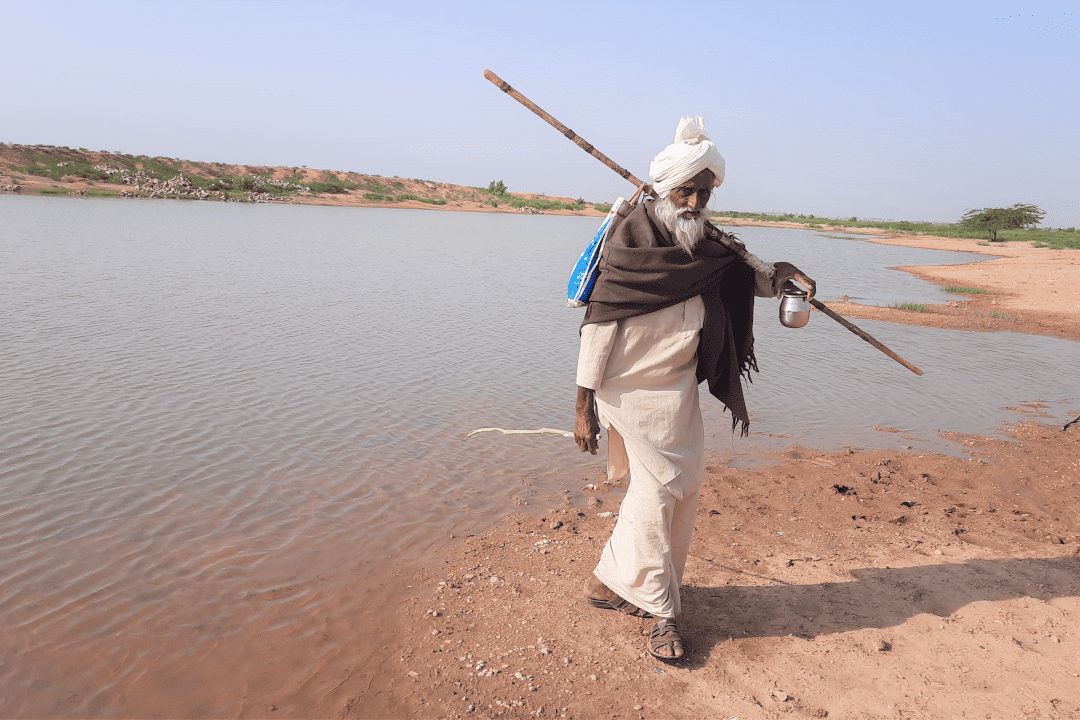Water Security
In the desert, the most natural resource, water is absent. Non-arrival of critical rain can devastate the life cycles of the entire population living in the Thar tearing apart families, and communities and causing them to migrate. Water is their constant struggle and such scarcity of water jeopardizes the health of villagers not only when the reserves are low but also whenever high concentrations of minerals degrade its quality. To add to this, modernization during the past century brought with it its perils and unsustainable change which was to last for an era. Excessive reliance on drinking water tube wells led to mounting operating costs and sinking groundwater levels. Over time traditional techniques started to fall apart and when that happened the ones to suffer the most were the ones who were marginalized and had the least or no access to resources. While the poor could not afford to independently maintain and operate these mechanized systems, women had to fetch water from long distances.
To tackle this deepening crisis, GRAVIS entered the region intending to help villages regain self-sufficiency and sustainability. This could become possible only if access to water was availed and sustained. Achieving water security is hard but it is the most basic need for human civilization to be able to survive and exist. Hence, this became the first and the most important goal for us to mitigate the socio-economic impact of accumulated drought years in the Thar.
One of the key strategies of GRAVIS to achieve water security was to promote and advocate for the age-old traditional water harvesting techniques and structures. These are easy for the villagers to maintain, more environmentally sustainable and practised for hundreds of years. With these methods, even little rainfall can yield enormous benefits and harvest substantial quantities of water which would easily meet the needs of inhabiting communities.
To tackle this deepening crisis, GRAVIS entered the region intending to help villages regain self-sufficiency and sustainability. This could become possible only if access to water was availed and sustained. Achieving water security is hard but it is the most basic need for human civilization to be able to survive and exist. Hence, this became the first and the most important goal for us to mitigate the socio-economic impact of accumulated drought years in the Thar.
One of the key strategies of GRAVIS to achieve water security was to promote and advocate for the age-old traditional water harvesting techniques and structures. These are easy for the villagers to maintain, more environmentally sustainable and practised for hundreds of years. With these methods, even little rainfall can yield enormous benefits and harvest substantial quantities of water which would easily meet the needs of inhabiting communities.
Rainwater Harvesting Structures & Technology

The primary focus of this intervention has been on mobilization and empowerment of rural communities for natural resource management by setting up of traditional water harvesting structures such as village ponds (naadis), percolation wells (beris) and drinking water tanks (taankas). GRAVIS also focuses on capacity building of rural communities so that they themselves come forward to restore traditional water harvesting structures for community use and water security.
Taanka

It is an underground drinking water storage tank with about 25,000 litres capacity and harvests rainwater. Water is gathered in one of two ways: either a rooftop catchment which pipes water into the unit, or a groundwater catchment area where water pours in through a grate on the side. Previously, these taankas were open to the air and were easily contaminated. In order to keep the water clean and safe to drink, GRAVIS has installed silt catchers and secure lids to keep out animals, insects and mud. One taanka can support a family of 10 for 4-8 months of the year.

Naadi

It is a village pond, excavated on common lands and stores rainwater. It is a major source of drinking water for human and cattle population. These village ponds are natural collections of rainwater which provide an open source of water to entire villages. Unfortunately, if not kept up properly the ponds can become silted and unusable. In order to remove silt and debris, we have been building short loose rock structures in the water pathway to the naadi to keep gravel, sand, and other material from entering the pond. Local materials are used and much of the labour is done by villagers voluntarily. These rocky borders also help to replenish the soil outside the naadi with moisture and fertile topsoil. Natural vegetation grows easily in these areas and helps to further reduce soil erosion and silting of the naadi. A medium sized naadi provides community with water for 2-6 months in a year of average rainfall, whereas big ones carry water all year round.

Beri

It is a percolation well that stores about 50,000 to 100,000 liters of underground water used in dry periods These large underground water storage percolators are covered with a concrete top and gather ground water during monsoon season. It does not require a pump, making it easy for villagers to fix and maintain. This traditional method of water gathering uses no artificial catchment and holds enough water to sustain a family of 10 for up to two years.
Bio Sand Water Filters (BSWF)

It is a low-cost technology that improves the quality of drinking water through filtration. This technology uses local materials to filter and clean drinking water. A concrete box about 1 m height is filled with a layer of coarse gravel, finer gravel, and a larger layer of sand which filters the water. Above is a liquid layer containing micro-organisms which consume pathogens in the water. On top is a diffuser which protects the filter contents when water is poured in for filtration. After the water passes through all these materials it flows out of a tube and into a sealed water storage unit.

Impact
- Immediate resolution of the water crisis faced by both humans and animals – thus ensuring availability of clean drinking water.
- Greater drought preparedness of the village community. With availability of clean drinking water there has been an improvement in the health conditions and hygiene behaviour of the community.
- Improved access and availability of water has enhanced economic gains for the poor communities and improved productivity in the countryside.
- Various indirect benefits of the water resource management programme include increased attendance of school children, especially girls, improvement in health and hygiene and free time for women as they spend less time fetching water.

